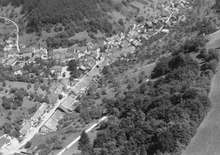Hemmental
Hemmental was a municipality in the canton of Schaffhausen in Switzerland. In 2009 Hemmental merged with Schaffhausen.[1]
Hemmental | |
|---|---|
Hemmental village | |
 Coat of arms | |
Location of Hemmental 
| |
 Hemmental  Hemmental | |
| Coordinates: 47°44′N 8°35′E | |
| Country | Switzerland |
| Canton | Schaffhausen |
| District | n.a. |
| Government | |
| • Mayor | Hermann Schlatter |
| Area | |
| • Total | 10.78 km2 (4.16 sq mi) |
| Elevation | 588 m (1,929 ft) |
| Population (December 2005) | |
| • Total | 542 |
| • Density | 50/km2 (130/sq mi) |
| Postal code | 8231 |
| SFOS number | 2934 |
| Surrounded by | Beggingen, Beringen, Merishausen, Schleitheim, Schaffhausen, Siblingen |
| Website | www Profile (in German), SFSO statistics |
Hemmental was roughly 4.5 km (2.8 mi) outside of the city limits of Schaffhausen and 7 km (4.3 mi) away from the Schaffhausen train station.

First Settlement
It is generally accepted that Hemmental was settled between the 7th and 8th centuries by the Alemans. Local tradition states that the village was named after a Germanic priest probably named Hemo. According to the records of Burkhard of Nellenburg, in 1090 Hemo gave Hemmental, together with Buesingen and Berslingen, to the Abbey of Allerheiligen in Schaffhausen.[2] About 30 families may have lived at that time in Hemmental.
Leu, Schlatter, Hatt and Mettler families
In the year 1483, the name "Schlatter" first appears in Hemmental, followed by those of "Mettler", "Hatt" and "Leu". These families dominated in the area. Today, there are also the four place names, Schlatter, Leuen, Hatten and Mettlerhof reflecting this influence. Three of these family names still prevail in Hemmental; the name Mettler no longer being found here. It is these four names which, in 1951, led to the resolution that a new village coat of arms be introduced - four golden stars on blue and red shield. The blazon of the municipal coat of arms is Per saltire Gules and Azure in each a Mullet Or.[3]
Geography
Hemmental had an area, as of 2006, of 10.9 km2 (4.2 sq mi). Of this area, 26.6% is used for agricultural purposes, while 70.3% is forested. The rest of the land, (3%) is settled.[4] It is a farming village at the foot of the Randen range.
Demographics
In the 2007 federal election the most popular party was the SVP which received 53.9% of the vote. The next two most popular parties were the SP (27.2%), and the FDP (18.8%).[4]
The historical population is given in the following table:[2]
| year | population |
|---|---|
| 1771 | 241 |
| 1798 | 305 |
| 1836 | 372 |
| 1850 | 409 |
| 1900 | 496 |
| 1950 | 409 |
| 2000 | 513 |
References
- Amtliches Gemeindeverzeichnis der Schweiz published by the Swiss Federal Statistical Office (in German) accessed 23 September 2009
- Hemmental in German, French and Italian in the online Historical Dictionary of Switzerland.
- Flags of the World.com Archived 2011-06-05 at the Wayback Machine accessed 15-December-2009
- Swiss Federal Statistical Office Archived 2011-09-04 at the Wayback Machine accessed 15-December-2009
| Wikimedia Commons has media related to Hemmental. |
External links
- Hemmental in German, French and Italian in the online Historical Dictionary of Switzerland.